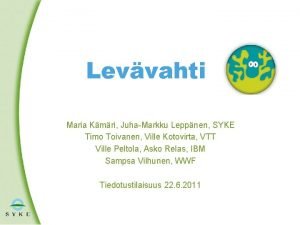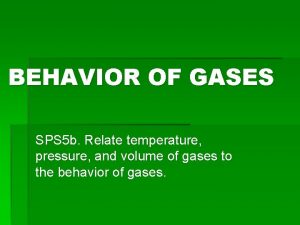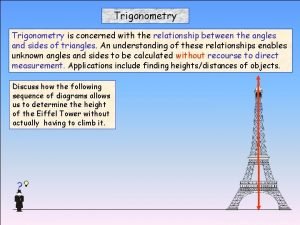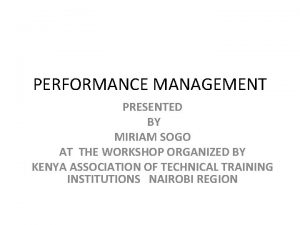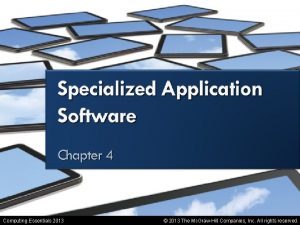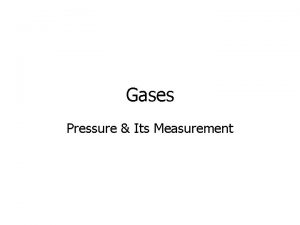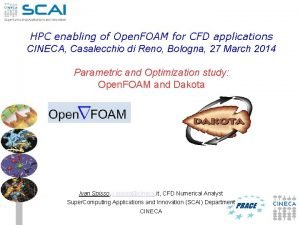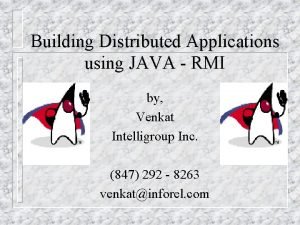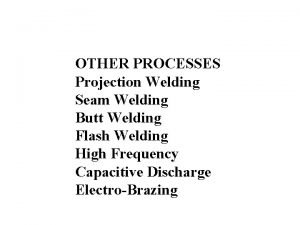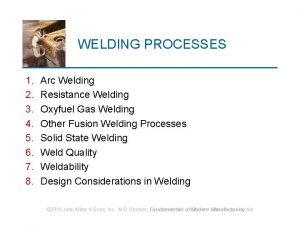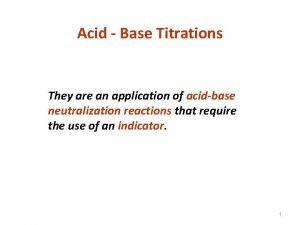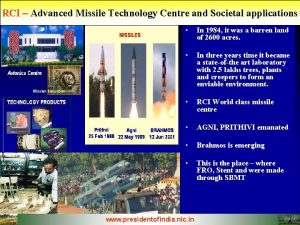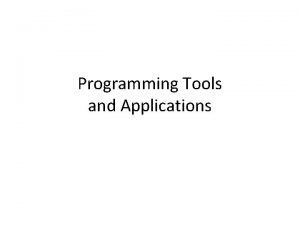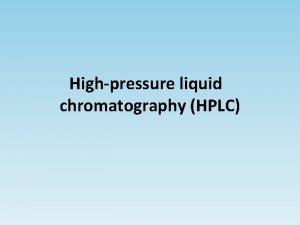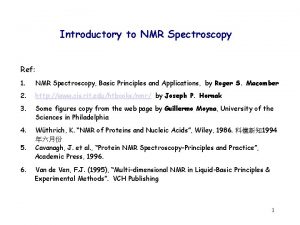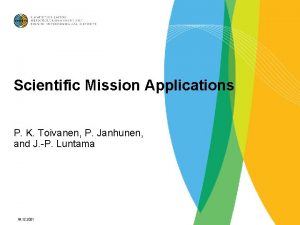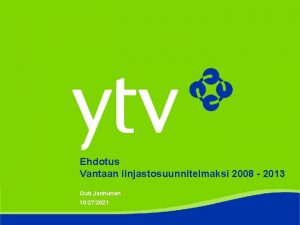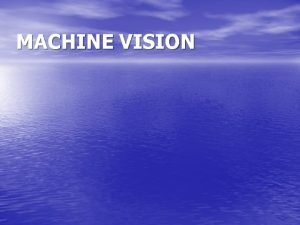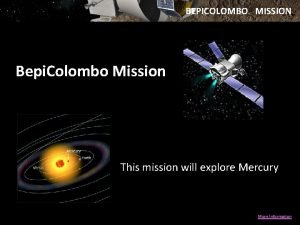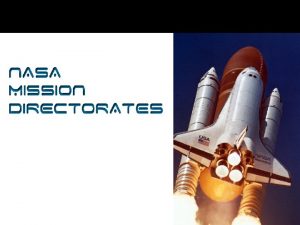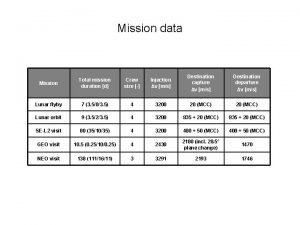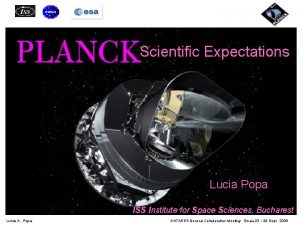Scientific Mission Applications P K Toivanen P Janhunen





















- Slides: 21

Scientific Mission Applications P. K. Toivanen, P. Janhunen, and J. -P. Luntama 28. 10. 2021

Outline Example mission to Mars Optimal orbit to Mars • Optimal operation of the sail • Optimal operations and real solar wind Solar wind variations and sail performance • Density variations • Wind speed variations • Average performance • Tether voltage and navigation Ilmatieteen laitos / Power. Point ohjeistus 28. 10. 2021 2

Electric sail and science missions About mass budget of electric sail About economics of electric sail missions Interstellar Heliospheric Probe (IHP) Kuiper/centaur flyby mission Asteroid tour Space weather monitoring Ilmatieteen laitos / Power. Point ohjeistus 28. 10. 2021 3

Optimal orbit to Mars Mengali, Quarta, and Janhunen: • Journal of Spacecraft and Rockets, 2008. • Solar wind speed, 400 km/s • Density, 7. 3 cm-3 • Electron temperature, 12 e. V • Radial scaling laws for the solar wind parameters • Total mass 200 kg Ilmatieteen laitos / Power. Point ohjeistus 28. 10. 2021 4

Optimal operation of the sail Optimal solution includes: • Initial acceleration of about 0. 5 mm/s 2 (Earth) • Coasting phase (shading) • Constant thrust angle of 20 deg • Acceleration at Mars of about 0. 3 mm/s 2 • Travel time of 600 days Ilmatieteen laitos / Power. Point ohjeistus 28. 10. 2021 5

Optimal operations and real solar wind Varying density and speed: • Acceleration varies about 40% around the average • Mars missed! • But s/c kind of got there… Ilmatieteen laitos / Power. Point ohjeistus 28. 10. 2021 6

Solar wind variations and sail performance Some severe weather conditions: • Densities higher than 30 cm-3 may occur • Solar wind speed may be higher than 1000 km/s • Variations in acceleration far more mellow than those of the solar wind driving the sail Ilmatieteen laitos / Power. Point ohjeistus 28. 10. 2021 7

Density variations Acceleration limited: • Electron current to the tethers increases • Electron gun power limited by the given solar panel power • Tether voltage drops Ilmatieteen laitos / Power. Point ohjeistus 28. 10. 2021 8

Wind speed variations #1 Acceleration is regulated: • Solar wind speed drive not linear: Ilmatieteen laitos / Power. Point ohjeistus 28. 10. 2021 9

Wind speed variations #2 For small wind speed values: • Solar wind kinetic energy less than the tether electric potential • Dynamic pressure term dominates For large wind speed values: • Solar wind kinetic energy larger than the tether electric potential • Solar wind penetrates to the tether potential structure Ilmatieteen laitos / Power. Point ohjeistus 28. 10. 2021 10

Average performance #1 3 -month averaged thrust in cases of: • Limited tether voltage (40 k. V, thick) • No tether voltage limitation (thin) • Variations relatively small around average at 70 n. N/m • Missions can be desinged for the minimum thrust (dotted) without missing much of the maximum thrust (dashed) Ilmatieteen laitos / Power. Point ohjeistus 28. 10. 2021 11

Average performance #2 Thrust vs. solar panel power: • For small power values, difference between the maximum and minimum thrust not large • For large power values, the minimum thrust saturates Ilmatieteen laitos / Power. Point ohjeistus 28. 10. 2021 12

Average performance #3 Thrust vs. averaging window: • Down to averaging over about ten days, difference between maximum and minimum thrust does not change dramatically • Averages below ten days are not relevant in mission time scales Ilmatieteen laitos / Power. Point ohjeistus 28. 10. 2021 13

Tether voltage and navigation Simple navigation procedure: • Onboard accelerometer • Time-integrate measured acceleration for spacecraft speed, Vsc • Compare hourly Vsc with speed at optimal orbit, V 0 • If Vsc < V 0, increase tether potential by 5 k. V for the next hour • If Vsc > V 0, decrease tether potential by 5 k. V for the next hour Ilmatieteen laitos / Power. Point ohjeistus 28. 10. 2021 14

Electric sail and science missions High delta-v for small payloads Interplanetary Heliospheric Probe (IHP) Kuiper/Centaur flyby mission Asteroid tour Space weather monitoring Other missions Near-solar missions Planetary missions Ilmatieteen laitos / Power. Point ohjeistus 28. 10. 2021 15

Electric sail propulsion system 100 X 20 km aluminium four-fold Hoytether Tethers: 7. 3 kg (20 µm) Reels: 22. 0 kg (3 X tethers) Electron gun + radiator: 1. 5 kg (40 k. V & 1 k. W) High-voltage power source: 2. 0 kg Avionics + tether direction sensor: 7. 0 kg Solar panels: 6. 0 kg (1. 1 k. W) Battery Li-ion: 1. 0 kg (8 Ah) S/c frame with thermal isolation: 4. 5 kg AOCS thrusters: 1. 0 kg Total: 52. 3 kg Ilmatieteen laitos / Power. Point ohjeistus 28. 10. 2021 16

About economics of electric sail missions Payload more expensive than the launch Soyuz-fregat: 1. 3 ton payload to escape orbit Electric sailer with 1. 3 ton payload accelerates slowly Smaller booster saves no that much 4 -6 electric sailers per launch Piggybag Ilmatieteen laitos / Power. Point ohjeistus 28. 10. 2021 17

Interstellar Heliospheric Probe Fast flight to interstellar medium: • Formation of the heliosphere • Pioneer anomaly • Present proposed mission time is tens of years • Electric sailer is an enabling technology • Reduced travel time • Weight issue • Use of several electric sailers Ilmatieteen laitos / Power. Point ohjeistus 28. 10. 2021 18

Kuiper/centaur flyby mission Properties of primoidal objects: • Group of flyby probes, target per probe • One launch with Siamise Twins spin-up for each pair • Small payload (total mass 150200 kg) • Minimal instrument set only to study the target • Fast travel time • Fast flyby, data into memory and slow downloading Ilmatieteen laitos / Power. Point ohjeistus 28. 10. 2021 19

Asteroid tour More for the same money: • Single electric sailer can visit several asteroids • Water/hydrogen on asteroids • Mineral composition • Morphology • Imager, radar, and spectroscope (infrared, neutron, and gamma) • Shoot bullet with a railgun • Laser heating • Micrometeor flashes on dark side Ilmatieteen laitos / Power. Point ohjeistus 28. 10. 2021 20

Space weather monitoring Off-Lagrange point monitoring: • Propellantless operation needed • Longer than the 1 -hour time delay to Earth (solar wind) • Solar wind monitoring for other planet missions (as a piggybag) • Tether voltage cycled: • off during monitoring • on during orbit control Ilmatieteen laitos / Power. Point ohjeistus 28. 10. 2021 21
 Timo toivanen
Timo toivanen Henrietta toivanen
Henrietta toivanen Thermofisher mission statement
Thermofisher mission statement How is a scientific law different from a scientific theory?
How is a scientific law different from a scientific theory? Information gathered during an experiment
Information gathered during an experiment Application of charles law in real life
Application of charles law in real life Applications of trigonometry
Applications of trigonometry Technology applications ec-12
Technology applications ec-12 Specialized applications
Specialized applications Unit of pressure
Unit of pressure Ob applications of emotions and moods
Ob applications of emotions and moods Egi applications
Egi applications Cfd applications
Cfd applications Distributed application in java
Distributed application in java Butt seam welding
Butt seam welding Groover
Groover Titration procedure
Titration procedure Rci web applications
Rci web applications Applications
Applications Applications of high performance liquid chromatography
Applications of high performance liquid chromatography Nmr applications
Nmr applications Applications of pumping lemma
Applications of pumping lemma
